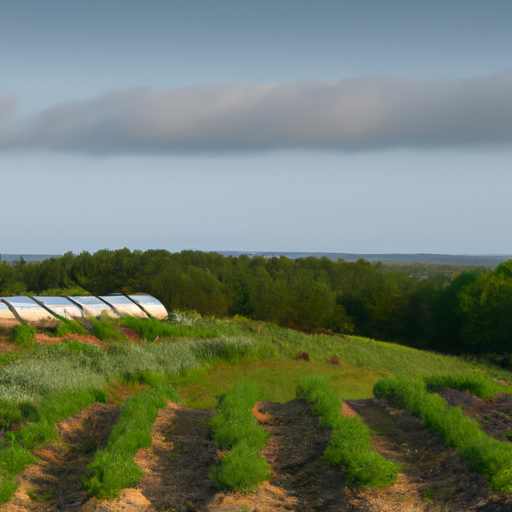Imagine being able to grow your own feed ingredients and save money in the process. It might sound too good to be true, but it could actually be a cost-effective alternative for farmers. By taking control of the ingredients that go into their livestock’s feed, farmers can not only ensure the quality and freshness of the feed, but also potentially reduce their expenses. In this article, we will explore the concept of growing your own feed ingredients and examine whether it is a viable and economical option for farmers.
Benefits of Growing Your Own Feed Ingredients
Reduced Costs
Growing your own feed ingredients can significantly reduce the costs of feeding your livestock. By eliminating the need to purchase expensive commercial feed, you can save a substantial amount of money in the long run. Not only are you bypassing the markups of middlemen and retailers, but you also have the opportunity to cut out the transportation and storage costs associated with commercially produced feed. With careful planning and management, you can grow high-quality feed ingredients at a fraction of the cost.
Quality Control
When you grow your own feed ingredients, you have full control over the quality of the feed that your livestock consumes. You no longer have to worry about potentially harmful additives or low-quality ingredients that may be present in commercial feeds. By monitoring the cultivation process, you can ensure that the crops are grown using sustainable and environmentally friendly practices. This ultimately translates to healthier and more nutritious feed for your animals, leading to better performance and overall well-being.
Sustainability
Growing your own feed ingredients contributes to a more sustainable farming system. By reducing your dependence on external suppliers and the associated transportation, you can significantly decrease your carbon footprint. Additionally, incorporating crop rotation and diverse planting practices can enhance soil health and fertility, minimizing the need for synthetic fertilizers and pesticides. This sustainable approach to feed production not only benefits your farm but also the environment as a whole.
Considerations for Growing Your Own Feed Ingredients
Land Availability
One crucial consideration when growing your own feed ingredients is the availability of suitable land. Assessing the quantity of land needed to sustainably produce enough feed for your livestock is essential. Factors such as soil quality, water availability, and access to sunlight must be taken into account. It is also important to consider the size and type of livestock you have, as different animals have varying feed requirements. While small-scale operations may be able to grow enough feed on existing land, larger farms may need to explore land expansion or alternative feed sourcing options.
Resources and Expertise
Growing your own feed ingredients requires adequate resources, including labor, equipment, and knowledge. Assessing your existing resources and deciding whether you have sufficient capacity to take on feed production is crucial. It may require additional investment in machinery and infrastructure or hiring trained personnel. Additionally, acquiring the necessary expertise in crop cultivation, pest management, and harvesting techniques is essential for success. Consider partnering with agricultural experts or attending training programs to enhance your knowledge and skills.
Crop Rotation and Diversity
An important aspect of growing your own feed ingredients is implementing crop rotation and diversifying the types of crops you grow. Crop rotation is the practice of alternating the crops grown in a specific area from season to season. This technique helps reduce soil erosion, increases soil fertility, and minimizes the risk of disease and pests. Additionally, diversifying the types of feed crops grown can provide a balanced and nutritious diet for your livestock. Incorporating a variety of protein-rich, energy-dense, and fiber sources ensures that your animals receive a well-rounded nutritional profile.
Choosing Suitable Crops for Feed Ingredients
Protein-Rich Crops
Protein is a crucial component of animal feed, as it supports growth, muscle development, and overall health. When choosing crops for feed ingredients, prioritize those that are rich in protein. Soybeans, for example, are a popular choice due to their high protein content. Other suitable options include peas, alfalfa, and sunflower seeds. It is essential to consider the specific protein needs of your livestock and select crops that can meet those requirements.
Energy-Dense Crops
Energy-dense crops provide the necessary calories and carbohydrates for your animals’ energy needs. Corn and barley are common examples of energy-dense crops used in livestock feed. These crops are rich in starch, providing a readily available source of energy. However, it is important to balance the inclusion of energy-dense crops with other nutrient-rich ingredients to ensure a well-rounded diet.
Fiber Sources
Fiber is an essential part of an animal’s diet as it aids in digestion and promotes gut health. Incorporating fiber sources into feed ingredients is crucial to ensure the overall well-being of your livestock. Legume hays, grasses, and straw are commonly used fiber sources. Additionally, certain crop residues, such as corn stalks and wheat straw, can also be utilized. Careful consideration should be given to the specific fiber requirements of your animals and the agronomic conditions needed to successfully grow these crops.
Factors Affecting Cost-Effectiveness
Initial Investment
Growing your own feed ingredients may require an initial investment in infrastructure, machinery, and seeds. Assessing your budget and determining the feasibility of such an investment is crucial to ensure long-term cost-effectiveness. It is important to estimate the payback period for the initial investment and consider potential financing options or grants that may be available to support your venture.
Labor and Time
Growing feed ingredients requires dedicated labor and time commitment. Planting, irrigating, fertilizing, and harvesting crops demand regular attention and care. Assessing your farm’s labor capacity and determining if you have the resources to manage a new feed ingredient production system is essential. Consider the trade-offs between using existing resources for other farm activities and the potential benefits gained by growing your own feed.
Yield Potential
Estimating the yield potential of your chosen crops is crucial for cost-effectiveness. The amount of feed your crops yield will directly impact the amount of feed you can produce and, subsequently, the amount of money saved. Conduct thorough research on crop yield projections and consult with local agricultural experts to ensure realistic expectations. Additionally, assessing the market demand for your chosen crops and their potential profitability is crucial for cost-effectiveness.
Managing Risks in Growing Feed Ingredients
Weather Conditions
Weather fluctuations and extreme conditions can have a significant impact on crop production and overall feed availability. Droughts, floods, and temperature extremes can negatively affect crop growth and yield. It is important to stay informed about local weather patterns and implement appropriate strategies to mitigate potential risks. This may include investing in irrigation systems, implementing water conservation practices, or selecting drought-resistant crop varieties.
Pests and Diseases
Pests and diseases pose a constant threat to crop health and productivity. Identifying and managing potential pests and diseases requires ongoing monitoring and prompt interventions. Implementing integrated pest management strategies that combine cultural, biological, and chemical control methods can help protect your crops. Regular scouting, crop rotation, and maintaining overall farm hygiene are essential practices in minimizing pest and disease risks.
Market Volatility
Growing your own feed ingredients may expose you to market volatility, as the availability and prices of externally sourced feed can fluctuate. However, by diversifying your crops, you can potentially mitigate some of this risk. For example, if the price of one crop increases, you may have an alternate crop that can be used instead. Additionally, establishing relationships with local buyers or exploring direct sales to other farmers can provide more stability in your feed market.
Alternative Sources of Feed Ingredients
Local Farmers and Cooperatives
If growing your own feed ingredients poses challenges or is not feasible, consider sourcing feed from local farmers or cooperatives. Collaborating with nearby farms can provide access to a wider range of feed ingredients while supporting the local agricultural community. This approach may also enable you to obtain high-quality feed at competitive prices, potentially reducing your overall feeding costs.
Waste and By-Products
Another alternative source of feed ingredients is utilizing waste and by-products from other agricultural or food processing activities. For example, vegetable scraps, fruit pomace, or spent grains from breweries can be repurposed as feed. Assessing the availability and suitability of such waste materials in your area is essential. Keep in mind that proper storage, handling, and processing may be required to ensure the safety and nutritional value of these feed ingredients.
Forages and Pasture
Forages and pasture are natural feed sources that can be efficiently utilized by livestock. If you have available land, consider incorporating grazing practices or cultivating forage crops. Depending on your location and climate, a variety of forage crops such as alfalfa, clover, or ryegrass can provide a nutritious feed source. By optimizing rotational grazing and using appropriate grazing management techniques, you can maximize feed availability while promoting animal health and pasture sustainability.
Calculating Cost-Effectiveness
Cost Comparison
To determine the cost-effectiveness of growing your own feed ingredients, conduct a cost comparison analysis. Compare the expenses associated with producing your own feed ingredients to purchasing commercially produced feed. Consider factors such as input costs (seeds, fertilizers, etc.), labor, machinery, and infrastructure maintenance. This analysis will provide insights into the potential savings and overall cost-effectiveness of growing your own feed.
Growth Potential
Another aspect to consider when assessing cost-effectiveness is the growth potential of your feed ingredient production system. Evaluate if there are opportunities for expansion, increased yields, or productivity improvements in the long term. Understanding the growth potential allows you to estimate the scalability and profitability of your venture.
Market Price Analysis
Lastly, analyze the market prices of feed ingredients to determine how they may impact the cost-effectiveness of growing your own feed. Research and monitor the trends and fluctuations in feed prices, taking into account the demand and supply dynamics. This analysis will help you anticipate any potential risks or opportunities associated with market volatility and its impact on the cost-effectiveness of producing your own feed ingredients.
Success Stories: Case Studies
Farm X: Growing Soybeans for Livestock Feed
Farm X successfully transitioned from purchasing expensive commercial feed to growing soybeans for their livestock. By carefully planning and managing their feed production system, they significantly reduced their feeding costs while maintaining the nutritional quality of their animals’ diet. With a focus on soil health and sustainability, Farm X implemented crop rotation practices and invested in proper machinery and irrigation systems. This success story showcases the benefits of growing protein-rich crops as a cost-effective alternative to commercial feed.
Farm Y: Utilizing Cover Crops for Feed
Farm Y adopted a unique approach by utilizing cover crops as a feed source for their livestock. By integrating cover crops into their existing crop rotation system, they were able to produce nutrient-rich forages while improving soil health. This allowed them to reduce their reliance on externally sourced feed, resulting in substantial cost savings. Farm Y’s experience highlights the importance of diversifying feed sources and maximizing the potential of available land and resources.
Farm Z: Transitioning to Organic Feed Ingredients
Farm Z decided to transition to organic feed ingredients, recognizing the market demand for organic products. By adapting their cultivation practices and obtaining organic certifications, Farm Z successfully tapped into a niche market. Despite the initial investment and additional labor required, they were able to achieve a premium price for their organic feed. This case study emphasizes the importance of market research and understanding consumer preferences when considering alternative feed ingredients.
Supportive Government Policies and Programs
Grants and Subsidies
Many governments offer grants and subsidies to support farmers in transitioning to alternative feed ingredient production systems. These financial incentives can help offset the initial investment and operating costs, making the transition more financially viable. By researching and accessing these grants and subsidies, farmers can tap into additional resources and support for their feed production ventures.
Technical Assistance
Government agencies and agricultural organizations often provide technical assistance to farmers interested in growing their own feed ingredients. This assistance may include training programs, expert advice, and personalized guidance on crop selection, cultivation techniques, and pest management. Taking advantage of these resources can help farmers overcome challenges and improve their chances of success.
Training and Education
Continual training and education are crucial for farmers to stay updated with the latest advancements in feed ingredient production. Government-led workshops, seminars, and educational programs enable farmers to enhance their knowledge and skills. By investing in training and education, farmers can gain valuable insights and access to best practices that can further improve the cost-effectiveness and sustainability of their feed production systems.
Conclusion
Growing your own feed ingredients can offer numerous benefits, including reduced costs, improved quality control, and enhanced sustainability. However, it is essential to carefully consider factors such as land availability, resources and expertise, suitable crop selection, and risk management. Conducting a thorough cost analysis and exploring alternative feed sourcing options can help determine the cost-effectiveness of growing your own feed. By learning from success stories, leveraging supportive government policies, and continuously seeking technical assistance and training, farmers can successfully embark on this path towards self-sufficiency and profitability.




